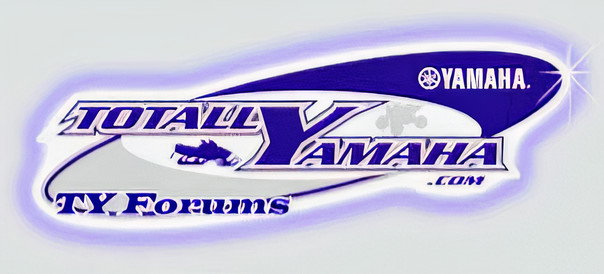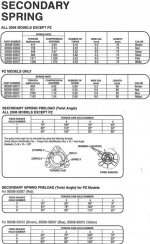ThatBlueVmax
New member
I got a 96 600 vmax xt and was wondering the pn # for the secondary spring, went to yamaha and they ordered a pink spring with the number 90508-536A9 for it.
A couple of bucks
VIP Member
Attachments
Last edited:
A couple of bucks
VIP Member
You need a 556A2
They ordered you a Red which is an alternate to the Green which is stock. The Red has a slightly smaller wire diameter (5.3 mm vs. 5.5 mm) and thus a lower torsion and compression rate. It will allow a quicker up shift and a slower downshift. Depending upon your type of riding you could prefer one over the other.
ThatBlueVmax
New member
What would I have to change on my clutches when I put the red spring in? And trail riding, off trail and racing
Backwoods M Max
New member
It's just going to up shift fast and back shift slow. By back shifting slow when you hammer it from part throttle you may encounter bogging issues because it's not letting the belt out to get the revs up. The primary is just going to grab a handful of belt and overload the motor. Like ding said it's an alternative to the green spring. For stock applications that green spring will be what you want 99% of the time. If your going drag racing for the day and just want to hold your revs a little higher as you shift you can increase your spring preload from 70 to 80 degrees. It's not the ideal way to tune engine rpm you should do it in the primary but for the day or to turn to snow conditions you can make small changes like that via secondary spring preload.
Now take that as the preferred Yamaha way of doing things, and the correct way to maximize cvt efficiency so the primary isn't fighting the secondary. If you look at the manual for my 99 Polaris 700 and it has the primary set up with the weights and springs by the book they will tell you to adjust secondary spring preload to tune max rpm. 1 position is good for 200 rpm at wot by their methods.
Now take that as the preferred Yamaha way of doing things, and the correct way to maximize cvt efficiency so the primary isn't fighting the secondary. If you look at the manual for my 99 Polaris 700 and it has the primary set up with the weights and springs by the book they will tell you to adjust secondary spring preload to tune max rpm. 1 position is good for 200 rpm at wot by their methods.
ThatBlueVmax
New member
Can anyone find me a eBay link for a green spring?
caravanman
New member
Backwoods M Max
New member
If you are unsure of the age of the springs in both clutches then they should be changed as a set. The springs will take a set and age over time but they age together so one doesn't so much effect the other. With a brand new secondary spring and a 20 year old primary spring it might not perform as you expected.
ThatBlueVmax
New member
Am replacing the secondary spring because sled is reving high and not going over 20 km/h with 7000 rpm on a trail then it shifts and RPM's go down, thinking spring is sticking also what is the primary spring I should be getting?
ThatBlueVmax
New member
Also bogs when punched sometimes, 5500 is when the bog kicks in, crank seals, carbs cleaned/checked air/fuel etc, checked fuel pump found some water in it, put new rollers in secondary, clutches cleaned, tried tors off no change, gas tank was cleaned out and new filter, no kinks in lines or anything, and still doing the bog when letting off and punching it
Backwoods M Max
New member
Springs don't stick your clutch is warn. Unless someone put an aftermarket clutch in it that's not a roller secondary. Either helix pads are warm and it's metal on metal or the bushings for the shaft are so worn it's getting cocked and binding.
Red spring is much softer than the green spring. That would make the problem worse not better.
It almost sounds like the preload on the secondary is all screwed up. Did you take it apart or a shop that worked on it? What is the secondary preload set at?
Red spring is much softer than the green spring. That would make the problem worse not better.
It almost sounds like the preload on the secondary is all screwed up. Did you take it apart or a shop that worked on it? What is the secondary preload set at?
ThatBlueVmax
New member
Not rollers sorry helix pads were changed, ordered a green one for secondary and new one for primary, what do you mean preload (new to newer sleds then a old tnt)
ThatBlueVmax
New member
I tore it apart after looking at forums and posts, did proper procedures like lock tight etc
Backwoods M Max
New member
The secondary spring needs to be rotated clockwise when you put the helix back on. There are 3 holes on the inside of the secondary and 4 holes on the helix with numbers. Those are use to tune helix preload angles. The stock setting is 70 degrees. You put the pin end of the spring in hole one on in the clutch body. You put the other pin end in hole 6 on the helix. You rotate the helix clockwise (if doing this on the sled) until the helix goes over the studs. If your doing it on the bench you hold the helix and rotate the clutch counter clockwise. Without proper spring preload it won't shift correctly which sounds exactly what happened. If you didn't have a manual and were not familiar with Yamaha clutches it sounds very possible it got put back together wrong.
ThatBlueVmax
New member
Thanks, will take a look at preload, I remember we put the spring in hole 2 I believe on helix and can't remember other
You might want to check your primary weight arms and bushings.



